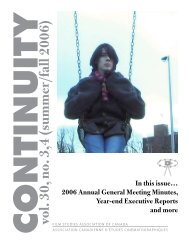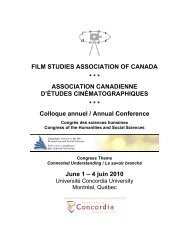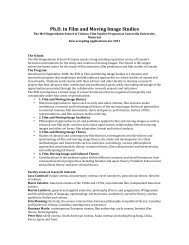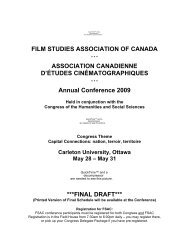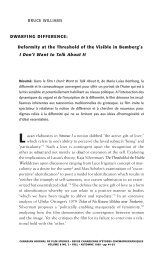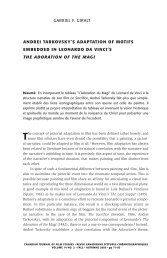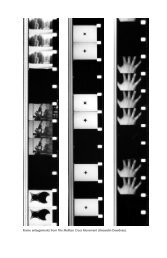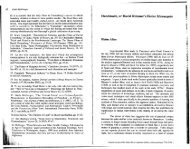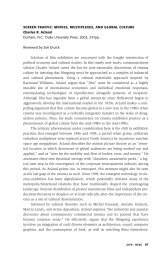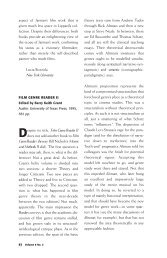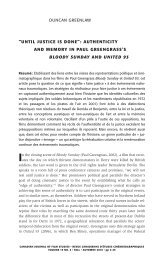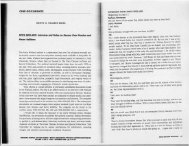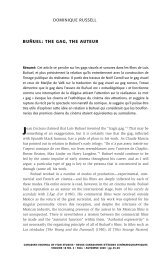The Missing Mythology: Barthes in Québec - Film Studies ...
The Missing Mythology: Barthes in Québec - Film Studies ...
The Missing Mythology: Barthes in Québec - Film Studies ...
Create successful ePaper yourself
Turn your PDF publications into a flip-book with our unique Google optimized e-Paper software.
CI NÉ-DOCU M ENTS<br />
SCOTT MACKENZIE<br />
TH E M ISSI NG MYTHOLOGY:<br />
<strong>Barthes</strong> <strong>in</strong> <strong>Québec</strong><br />
Résumé : Cet article, qui <strong>in</strong>troduit la traduction ci-dessous, exam<strong>in</strong>e le travail de collaboration<br />
de Roland <strong>Barthes</strong> et Hubert Aqu<strong>in</strong> sur le film Le Sport et les hommes.<br />
En plus de combler une lacune dans l’histore du documentaire à l’ONF/NFB, l’auteur<br />
(qui a traduit le texte de <strong>Barthes</strong>) offre une nouvelle lecture de l’<strong>in</strong>térêt particulier<br />
que <strong>Barthes</strong> voue au sport-comme-spectacle-filmé.<br />
<strong>Film</strong> history, like all historical narratives, is filled with gaps and fissures.<br />
Often, though, rediscover<strong>in</strong>g what is elided <strong>in</strong> film history offers us<br />
greater <strong>in</strong>sight <strong>in</strong>to the concerns of, and trends with<strong>in</strong>, a national c<strong>in</strong>ema.<br />
A re-exam<strong>in</strong>ation of the French semiotician Roland <strong>Barthes</strong>’ collaboration<br />
with Québécois filmmakers <strong>in</strong> the early 1960s provides us with such a case.<br />
Much has been written about the c<strong>in</strong>éma direct films produced by the<br />
NFB/ONF’s (National <strong>Film</strong> Board of Canada/Office national du film) l’équipe<br />
française<strong>in</strong> the 1950s and 1960s and the profound <strong>in</strong>fluence these films had<br />
on documentary film practice <strong>in</strong> France and the United States. 1 Much has<br />
also been written about the <strong>in</strong>fluence of both la nouvelle vague and French<br />
philosophy—specifically, the advent of structuralism—on Québécois filmmakers<br />
dur<strong>in</strong>g this period. Yet, <strong>in</strong> spite of the fertile <strong>in</strong>terchanges which<br />
took place between Parisian and Québécois <strong>in</strong>tellectuals and cultural workers,<br />
little mention is made of Roland <strong>Barthes</strong>’ work with the Québécois<br />
writer, broadcaster and filmmaker Hubert Aqu<strong>in</strong> on a film called Le Sport et<br />
les hommes (1961). Pass<strong>in</strong>g references, at best, are made to <strong>Barthes</strong>’ collaboration<br />
with Aqu<strong>in</strong> <strong>in</strong> the key historical surveys of Québécois c<strong>in</strong>ema. 2<br />
None of the plethora of biographies and critical studies of <strong>Barthes</strong>’ work—<br />
<strong>in</strong>clud<strong>in</strong>g <strong>Barthes</strong>’ own Roland <strong>Barthes</strong> par Roland <strong>Barthes</strong>—mention his time<br />
<strong>in</strong> Montréal. 3 What is perhaps more surpris<strong>in</strong>g is that <strong>in</strong> the career-spann<strong>in</strong>g<br />
Œuvres complètes, published between 1993 and 1995, which not only<br />
CANADIAN JOURNAL OF FILM STUDIES • REVUE CANADIENNE D’ÉTUDES CINÉMATOGRAPHIQUES<br />
VOLUME 6 NO. 2 • PP 65-74
<strong>in</strong>gs together <strong>Barthes</strong>’ collected writ<strong>in</strong>gs, but also his <strong>in</strong>terviews and even<br />
the plan d’études for his courses, no mention is made of the film. 4 Even those<br />
<strong>in</strong> <strong>Québec</strong> who know about <strong>Barthes</strong>’ connection with the NFB/ONF typically<br />
refer to his acknowledgement <strong>in</strong> La lu te(Claude Jutra, Michel Brault,<br />
Marcel Carrière & Claude Fournier, 1961)—a film <strong>in</strong>spired, <strong>in</strong> part, by his<br />
essay “Le monde où l’on catche” from Mythologies—and leave his far more<br />
active role <strong>in</strong> script<strong>in</strong>g the commentary for Le Sport et les hommes by the<br />
wayside.<br />
As <strong>Barthes</strong>’ contribution to Québécois c<strong>in</strong>ema is often elided, so is the<br />
film career of Hubert Aqu<strong>in</strong>. While Aqu<strong>in</strong> is known primarily for his<br />
essays, radio broadcasts and fiction, he was employed by the NFB/ONF<br />
from 1960 to 1963, work<strong>in</strong>g on seven films dur<strong>in</strong>g his three year career<br />
there: L’homme vite (dir. Guy Borremans; prod. Aqu<strong>in</strong>, 1960); Le Sport et les<br />
hommes (dir. Aqu<strong>in</strong>, 1961); Le Temps des amours (co-dir. Aqu<strong>in</strong>, 1961); Jour après<br />
jour (dir. Clémont Perron; prod. Aqu<strong>in</strong>, 1962); La f<strong>in</strong> des étés (dir. Anne-Claire<br />
Poirier; co-script Aqu<strong>in</strong>, 1963); À l’heure de la décolonisation (dir. Monique<br />
Fortier; script Aqu<strong>in</strong>, 1963); and À Sa<strong>in</strong>t-Henri, le 5 septembre (dir. Aqu<strong>in</strong>,<br />
1964). He also worked on the translation of English language documentaries<br />
produced for the Comparisons series, re-shoot<strong>in</strong>g scenes and re- writ<strong>in</strong>g<br />
commentaries <strong>in</strong> French, <strong>in</strong> order to give the films a Québécois context.<br />
Le Sport et les hommes was the only French film—that is, produced <strong>in</strong><br />
French first—to emerge from the Comparisons series. Comprised of n<strong>in</strong>eteen<br />
films produced by the NFB/ONF for broadcast on the CBC and Radio-<br />
Canada between 1959 and 1964, the series was essentially an attempt at<br />
the cross-cultural analysis of national practices <strong>in</strong> a comparative context.<br />
Whatever the “practice” under consideration, it was analysed <strong>in</strong> light of the<br />
national identity of the country <strong>in</strong> which the activity took place. <strong>The</strong> role<br />
played by <strong>in</strong>ternationalism <strong>in</strong> this series could be seen as pro-Canadian<br />
propaganda (Canada has a national culture just as India or Germany have<br />
national cultures), but the propagandistic impulse was offset when the<br />
“Canadian” sequences were re-shot <strong>in</strong> <strong>Québec</strong>, <strong>in</strong> French, for broadcast on<br />
Radio-Canada.<br />
In an article about <strong>Barthes</strong>’ connection with the NFB/ONF, Joyce<br />
Nelson writes the follow<strong>in</strong>g about the series:<br />
Each production <strong>in</strong>volved on-location shoot<strong>in</strong>g <strong>in</strong> four different<br />
countries; a famous expert <strong>in</strong> the relevant field scripted the commentary<br />
and appeared on-camera for studio sequences which bridged the<br />
location footage. For each film there was a team of at least five<br />
directors and crews, with Ian MacNeill responsible for all the studio<br />
66 Volume 6 No. 2
shoot<strong>in</strong>g, and a different director sent to each of the four countries<br />
be<strong>in</strong>g compared. 5<br />
Commentators employed <strong>in</strong> the series <strong>in</strong>cluded anthropologist Margaret<br />
Mead, historian Arnold Toynbee, film producer James Beveridge and poet<br />
and law professor Frank Scott, among others.<br />
After the first four films were shot, the Board’s budget for the series<br />
was nearly depleted. 6 <strong>The</strong>refore Aqu<strong>in</strong>, who had a life-long passion for<br />
sports, proposed to make the film about the phenomenology of sports out<br />
of stock shots, as the Board could not afford another “prestige” film. In this<br />
way, Aqu<strong>in</strong> could direct a francophone film as a part of the Comparisons<br />
series. In April of 1960, Aqu<strong>in</strong> re-read <strong>Barthes</strong>’ Mythologies, a text that was<br />
quite <strong>in</strong>fluential among Québécois <strong>in</strong>tellectuals at the time. 7 He then<br />
approached <strong>Barthes</strong> <strong>in</strong> a series of letters. In the first letter to <strong>Barthes</strong>, dated<br />
April 4, 1960, Aqu<strong>in</strong> writes, “My <strong>in</strong>tention is not to make a film on the history<br />
of sport, but rather one on its phenomenology and its poetics.” 8 In his<br />
prelim<strong>in</strong>ary letter Aqu<strong>in</strong> says that he wishes to address car rac<strong>in</strong>g <strong>in</strong> Italy,<br />
the Tour de France, hockey <strong>in</strong> Canada, and football <strong>in</strong> Hungary or bullfights<br />
<strong>in</strong> Spa<strong>in</strong>. Aqu<strong>in</strong> also states that the sports <strong>in</strong> question are open to<br />
negotiation, which <strong>in</strong>dicates how flexible he was will<strong>in</strong>g to be <strong>in</strong> order to<br />
get <strong>Barthes</strong> to work on the film. Aqu<strong>in</strong> did not want <strong>Barthes</strong> to simply write<br />
a commentary once the film was completed, but to participate <strong>in</strong> the film<br />
from its conception onward:<br />
If you accept to write a commentary for the f<strong>in</strong>al product, [I would<br />
wish] that you participate from the film’s <strong>in</strong>ception, with the orientation<br />
of the film when it beg<strong>in</strong>s. And here’s how: write to me, when<br />
you can, what you th<strong>in</strong>k of this subject overall, of its orientation;<br />
also tell me how you yourself imag<strong>in</strong>e the construction of this film. 9<br />
To undertake this work, Aqu<strong>in</strong> offered <strong>Barthes</strong> “about $250.00” for his <strong>in</strong>itial<br />
thoughts on the subject and $1000.00 for the f<strong>in</strong>al script, due six to<br />
eight months later. <strong>Barthes</strong> accepted. 10<br />
Aqu<strong>in</strong> wrote <strong>Barthes</strong> a second letter dated August 3, 1960. In it, he<br />
reiterated that they were not mak<strong>in</strong>g a film on the history of sports and<br />
that they had agreed to only address “sports-spectacles” and to put aside<br />
atheletics, solitary or Olympic sports. Aqu<strong>in</strong> goes on to discuss <strong>Barthes</strong>’<br />
suggestion that the film beg<strong>in</strong> with a brief history of sports, an idea that<br />
was dropped from the f<strong>in</strong>al film. He then comments on a contentious idea<br />
put forth by <strong>Barthes</strong>, given his later writ<strong>in</strong>gs on the photographic image<br />
CJFS / RCEC 67
and on joui sance. Aqu<strong>in</strong> writes: “You said that there’s no eroticism <strong>in</strong> sport.<br />
Quite right. On the other hand, <strong>in</strong> Greece women were banned from the<br />
stadium, and from the Middle Ages until just recently they were s<strong>in</strong>gularly<br />
absent from sport. <strong>The</strong> universe of sports is almost exclusively male.”<br />
Indeed, throughout his text, <strong>Barthes</strong> used only the mascul<strong>in</strong>e “homme” or<br />
“hommes” and never the gender-neutral “personne” or “huma<strong>in</strong>.” In relation<br />
to gender-specificity, it is also <strong>in</strong>terest<strong>in</strong>g to note that Aqu<strong>in</strong> ascribes eroticism-as-spectacle<br />
solely to the world of the fem<strong>in</strong><strong>in</strong>e.<br />
F<strong>in</strong>ally, Aqu<strong>in</strong> addresses the role the spectator plays <strong>in</strong> <strong>Barthes</strong>’ formulation<br />
of the sport<strong>in</strong>g spectacle. He writes:<br />
Coenesthesia. Here is one of the very <strong>in</strong>terest<strong>in</strong>g notions to be<br />
developed <strong>in</strong> our film. I hope to f<strong>in</strong>d adequate footage to illustrate it,<br />
but could you tell me if you plan to discuss this concept at great<br />
length? Do you consider coenesthesia a privileged form of identification<br />
between the spectator and the player? If so, this function, if well<br />
illustrated, becomes the occasion we need to talk about the public.<br />
<strong>The</strong>re’s also the `ancient chorus’ aspect of the public: the cries, the<br />
punctuations, the gasps that express the public’s participation <strong>in</strong> the<br />
spectacle. On this subject, essentially what difference do you see<br />
between the public’s participation <strong>in</strong> the theatre spectacle and the<br />
sports spectacle? Is there one? 11<br />
<strong>The</strong> ritualized aspect of sports-as-spectacle is developed <strong>in</strong> the film itself.<br />
A recurr<strong>in</strong>g theme of purg<strong>in</strong>g violence from society <strong>in</strong>to the spectacle of<br />
sport runs throughout the film. In this way, the film foreshadows the<br />
anthropological theories of scapegoat<strong>in</strong>g and mimesis later offered by<br />
René Girard. 12<br />
From these epistolary exchanges, the basic trajectory of the film<br />
emerged. Le Sport et les hommes would address the relationship between man<br />
and nature as it is ritualized <strong>in</strong> sport<strong>in</strong>g contests. <strong>The</strong> film would also<br />
address the profound <strong>in</strong>vestment spectators have <strong>in</strong> the events unfold<strong>in</strong>g<br />
before their eyes. Le Sport et les hommes, therefore, was an extension of the<br />
k<strong>in</strong>d of cultural semiotics undertaken by <strong>Barthes</strong> <strong>in</strong> Mythologies. For <strong>Barthes</strong>,<br />
the concept of mythical signification—found <strong>in</strong> everyday objects like<br />
advertisements, popular films, sport<strong>in</strong>g spectacles, and the like—explodes<br />
the traditional b<strong>in</strong>ary oppositions which pervade structural semiotics. This<br />
shift, outl<strong>in</strong>ed <strong>in</strong> Mythologies, redef<strong>in</strong>es the sign’s ability to communicate<br />
mean<strong>in</strong>g, as the external and historico-cultural system of signification<br />
overpowers the traditional b<strong>in</strong>ary between signifier and signified. Mean<strong>in</strong>g<br />
68 Volume 6 No. 2
then becomes socially negotiated, but not culturally explicit, as there is a<br />
naturalness assumed by the sign which “makes” the reader feel that mean<strong>in</strong>g<br />
is a priori, and not culturally determ<strong>in</strong>ed. 13 <strong>Barthes</strong> and Aqu<strong>in</strong> applied this<br />
notion of myth to sport, stripp<strong>in</strong>g away the ritualized violence <strong>in</strong> order to<br />
determ<strong>in</strong>e its social function. This approach also fit quite well with the k<strong>in</strong>d<br />
of cross-cultural analysis central to the philosophy of the Comparisons series.<br />
Aqu<strong>in</strong> assiduously researched the footage he wanted for his compilation<br />
film. He travelled to New York at the end of August 1960 to f<strong>in</strong>d stock<br />
footage. He then went to Paris on September 27, 1960 and stayed there<br />
until November 1. Dur<strong>in</strong>g this time, he met with <strong>Barthes</strong> to discuss the<br />
film. On his way back, he stopped over <strong>in</strong> London to research stock<br />
footage for the film at the BBC. 14 In the f<strong>in</strong>al film, stock shots came from<br />
many places, <strong>in</strong>clud<strong>in</strong>g the BBC <strong>in</strong> London, NBC <strong>in</strong> New York, and Leslie<br />
McFarlane’s Here’s Hockey! (NFB, 1953), from the Canada Carries On series.<br />
ASN’s (Associated Screen News) newsreel on the Richard riot at the<br />
Montréal Forum was used <strong>in</strong> the hockey section and even footage from<br />
Leni Riefenstahl’s Olympia (1938) was employed as part of the conclusion.<br />
Not one foot of raw stock was exposed <strong>in</strong> the mak<strong>in</strong>g of the film.<br />
<strong>Barthes</strong> arrived <strong>in</strong> Montréal on January 15, 1961 to work on the film;<br />
he stayed until January 25, 1961. While <strong>in</strong> Montréal, he was <strong>in</strong>terviewed<br />
on television by Réal Michaud and delivered lectures at Université Laval<br />
and Université de Montréal. Aqu<strong>in</strong> also <strong>in</strong>terviewed <strong>Barthes</strong> for his radioshow<br />
Carrefour, which was broadcast <strong>in</strong> two parts on February 28 and<br />
March 7. 15 Aqu<strong>in</strong> set <strong>Barthes</strong> up at the Board with a Steenbeck and a copy<br />
of the film. As Nelson notes: “He was presented with a cutt<strong>in</strong>g copy of the<br />
film, a shot list with tim<strong>in</strong>gs for each sequence, and given space at the<br />
Board for multiple view<strong>in</strong>gs.… ” 16 From this process, he created his commentary.<br />
<strong>The</strong> film’s producer, Guy Glover, ma<strong>in</strong>ta<strong>in</strong>s that <strong>Barthes</strong> could not<br />
demand that parts of the film be re-edited, added or deleted, and therefore<br />
contends that the film itself imposed limitations on <strong>Barthes</strong>’ analysis.<br />
Nelson notes that an analysis of Le Sport et les hommes “ … might reveal the<br />
visual structure <strong>Barthes</strong> had to work with—the filmic complications which<br />
placed him at one remove from sport as spectacle as the subject of analysis,<br />
and confronted him with filmed spectacle <strong>in</strong>stead.” 17 However, as we<br />
have seen, <strong>Barthes</strong> was very much <strong>in</strong>volved <strong>in</strong> the structur<strong>in</strong>g of the film<br />
before the edit<strong>in</strong>g process began.<br />
It is true, however, that <strong>Barthes</strong> was not simply writ<strong>in</strong>g about sportsas-spectacle,<br />
but about sports-as-filmed-spectacle. In this way, both the<br />
spectators on screen and the spectators <strong>in</strong> the audience were part of the<br />
coenesthetic process. Indeed, this is where Aqu<strong>in</strong>’s <strong>in</strong>terest <strong>in</strong> sports lay,<br />
CJFS / RCEC 69
and <strong>in</strong> his own writ<strong>in</strong>g on the phenomenology of sport, he was greatly<br />
<strong>in</strong>fluenced by McLuhan’s work on television and film as “cool” and “hot”<br />
media respectively. 18<br />
It is also <strong>in</strong>terest<strong>in</strong>g to note that <strong>Barthes</strong>’ first practical confrontation<br />
with the strengths and limitations of the c<strong>in</strong>ema as a mode of signification<br />
co<strong>in</strong>cided with advances <strong>in</strong> his <strong>in</strong>tellectual project. In the same year that<br />
Aqu<strong>in</strong> approached the philosopher to write the commentary for Le Sport et<br />
les hommes, <strong>Barthes</strong> wrote his first serious pieces of film theory, “Le problème<br />
de la signification au c<strong>in</strong>éma” and “Les « unités traumatiques » au c<strong>in</strong>éma.” 19<br />
<strong>The</strong>se essays comb<strong>in</strong>e the cultural semiotics first theorized <strong>in</strong> Mythologies,<br />
the politique des auteurs found <strong>in</strong> the pages of Cahiers du c<strong>in</strong>éma and the research<br />
undertaken by l’Institut de filmologie. 20 “La problème de la signification au<br />
c<strong>in</strong>éma” is an attempt to write a version of “Le mythe, aujourd’hui” for the<br />
c<strong>in</strong>ema, while “Les « unités traumatiques » au c<strong>in</strong>éma” engages with the<br />
<strong>in</strong>tellectual project of Gilbert Cohen-Séat and the Institut de filmologie. This<br />
po<strong>in</strong>ts to a major change <strong>in</strong> his work, at least <strong>in</strong> regard to the c<strong>in</strong>ema. Up<br />
until this po<strong>in</strong>t, <strong>Barthes</strong>’ writ<strong>in</strong>g on film had been limited to reviews of<br />
films by Bresson and Chabrol and to short pieces on iconic actors like<br />
Garbo and Brando for Mythologies.<br />
A few words about the film itself. Le Sport et les hommes was broadcast on<br />
Radio-Canada for the first time on June 1, 1961. It then ran <strong>in</strong> English as<br />
part of the Comparison series on the CBC. <strong>The</strong> English and French language<br />
versions were <strong>in</strong> distribution until 1977, when Le Sport et les hommes became<br />
an “archival film,” which could only be seen at the NFB/ONF or at the<br />
National Archives <strong>in</strong> Ottawa.<br />
<strong>The</strong> film beg<strong>in</strong>s with a brief montage of the different sports under<br />
exam<strong>in</strong>ation—bullfight<strong>in</strong>g, car rac<strong>in</strong>g, the Tour de France, hockey and<br />
soccer. <strong>The</strong>n, a title card appears which reads: “Le Sport et les hommes par<br />
Roland <strong>Barthes</strong>,” the only credit to appear at the beg<strong>in</strong>n<strong>in</strong>g of the film.<br />
While there is not enough space to analyse each of the five segments of<br />
the film, it is worthwhile to make a few prelim<strong>in</strong>ary comments about<br />
<strong>Barthes</strong>’ analysis: one <strong>in</strong> regard to the Tour de France and another <strong>in</strong> regard<br />
to Canadian hockey. <strong>The</strong>se two sections give us a good <strong>in</strong>dication of the<br />
types of semiotic and cultural analysis found <strong>in</strong> the film.<br />
By far, the longest sequence of the film deals with the Tour de<br />
France—a subject <strong>Barthes</strong> had already written about <strong>in</strong> Mythologies. In his<br />
essay, “Le Tour de France comme épopée,” <strong>Barthes</strong> writes: “<strong>The</strong> Tour thus<br />
possesses a veritable Homeric geography. As <strong>in</strong> the Ody sey, the race is<br />
here both a periplus of ordeals and a total exploration of the earth’s limits.”<br />
21 In many ways, this brief passage summarizes both <strong>Barthes</strong>’ vision of<br />
70 Volume 6 No. 2
the Tour de France and of sports as a whole: <strong>in</strong> both the aforementioned<br />
essay and the film, <strong>Barthes</strong> cont<strong>in</strong>uously returns to the notion of man overcom<strong>in</strong>g<br />
the “resistance of th<strong>in</strong>gs.” Indeed, a similar observation is present<br />
<strong>in</strong> the film, when <strong>Barthes</strong> states:<br />
It is these excesses, or worse still their contrasts, that the racer has<br />
to fight aga<strong>in</strong>st by cont<strong>in</strong>ued, <strong>in</strong>flexible effort. <strong>The</strong> resistance of the<br />
earth has to be added to the resistance of th<strong>in</strong>gs. <strong>The</strong> severest test<br />
set by nature for the cyclist is the mounta<strong>in</strong>. <strong>The</strong> mounta<strong>in</strong>—that is<br />
to say, gravity. To conquer the steep slope and the weight of matter<br />
is to assert that man is capable of controll<strong>in</strong>g the whole physical universe.<br />
But this conquest is such a difficult one that man must throw<br />
his whole self <strong>in</strong>to the task. This is why—as the whole country<br />
knows—the mounta<strong>in</strong>ous stretches are the key to the Tour; not so<br />
much because they decide the w<strong>in</strong>ner, but because they clearly manifest<br />
the true nature of what is at stake, the spirit of the contest, the<br />
virtues of the contestant. <strong>The</strong> end of the mounta<strong>in</strong> stretch is therefore<br />
the epitome of the whole human adventure.<br />
In the case of Canada, it is the weather itself which, <strong>Barthes</strong> posits, one<br />
must overcome and turn <strong>in</strong>to sport. Out of all five sports, it seems that<br />
hockey is the one which <strong>Barthes</strong> understands the least—it is also the sport<br />
that has lent itself most often to the c<strong>in</strong>emas of <strong>Québec</strong> and Canada.<br />
Hockey films have been a staple of Canadian and Québécois c<strong>in</strong>ema s<strong>in</strong>ce<br />
the days of the actualités, produced <strong>in</strong> nearly every style and genre imag<strong>in</strong>able,<br />
<strong>in</strong>clud<strong>in</strong>g animated films such as Sheldon Cohen’s <strong>The</strong> Sweater (1980),<br />
documentaries such as Gilles Groulx’s Un jeu si simple (1964), experimental<br />
films like William Cann<strong>in</strong>g’s Blades and Bra s (1967) and Bill Wees’ La Première<br />
Étoile/<strong>The</strong> First Star (1973) and fiction films, such as Michel Brault’s contribution<br />
to the omnibus film Montréal vu par … (Atom Egoyan, Denys Arcand,<br />
Patricia Rozema, Jacques Leduc, Léa Pool & Michel Brault, 1992). Unlike<br />
the po<strong>in</strong>t of view taken by most of the preced<strong>in</strong>g filmmakers, the vision of<br />
hockey offered by <strong>Barthes</strong> emphasizes its violence. <strong>Barthes</strong> considers<br />
hockey a sport where the symbolic battles between teams can quickly turn<br />
<strong>in</strong>to real violence between the players and, <strong>in</strong> the case of the Richard riots,<br />
violence on the part of the spectators. What is <strong>in</strong>terest<strong>in</strong>g about this<br />
approach to hockey is that the analysis offered by <strong>Barthes</strong> as to the ritualized<br />
nature of the violence <strong>in</strong> hockey and how it can spill over <strong>in</strong>to the<br />
world of the spectators became a guid<strong>in</strong>g theme <strong>in</strong> the films of l’équipe<br />
française. Similar to Le Sport et les hommes and the ethnographic films of Jean<br />
CJFS / RCEC 71
Rouch, such as Les Maîtres fous (1954), the sports films of l’équipe française<br />
went on to explore the relationship between ritual practices, the ma<strong>in</strong>tenance<br />
of community, and the processes of scapegoat<strong>in</strong>g and mimesis <strong>in</strong><br />
Québécois culture. La lu te (1961), Groulx’s Golden Gloves (1961) and Un jeu<br />
si simple (1964) and Gilles Carle’s Pat<strong>in</strong>oire (1962) all, to differ<strong>in</strong>g degrees,<br />
address themselves to these issues. This, as much as the work he did on Le<br />
Sport et les hommes and La lu te, is <strong>Barthes</strong>’ legacy to Québécois c<strong>in</strong>ema.<br />
F<strong>in</strong>ally, a note on the translation. As Mette Hjort writes <strong>in</strong> regard to<br />
the work of the translator: “If we speak of a translator’s preface or afterword<br />
as a genre or type of discourse, such rhetorical devices as apology, selfdenigration,<br />
and dichologia (excus<strong>in</strong>g failure by po<strong>in</strong>t<strong>in</strong>g to its necessity)<br />
would have to figure among the def<strong>in</strong><strong>in</strong>g criteria.” 22 I certa<strong>in</strong>ly feel the<br />
need to engage <strong>in</strong> dichologia <strong>in</strong> regard to translat<strong>in</strong>g the work of <strong>Barthes</strong>.<br />
Joyce Nelson notes that “Robert Russell translated from <strong>Barthes</strong>’ French, a<br />
task which Glover recognized as be<strong>in</strong>g `almost impossible because of<br />
<strong>Barthes</strong>’ richly nuanced style.’” 23 In many ways, this is true. Nevertheless, I<br />
have endeavoured to translate this “untranslatable” text, balanc<strong>in</strong>g the<br />
metaphors of <strong>Barthes</strong> with the demands of the English language. In undertak<strong>in</strong>g<br />
this translation, I consulted <strong>Barthes</strong>’ script, the orig<strong>in</strong>al film, the<br />
English version of the film (the translation of which is quite different from<br />
<strong>Barthes</strong>’ script) and a post-production translation of the script done for<br />
Grant McLean. I have used all these texts as resources, but have tried to<br />
reta<strong>in</strong> the <strong>in</strong>tegrity and spirit of <strong>Barthes</strong>’ script, to hold on to “the gra<strong>in</strong> of<br />
the voice.” For <strong>in</strong>stance, <strong>in</strong> both the French and English versions of the<br />
film, the commentary conta<strong>in</strong>s a few l<strong>in</strong>es not present <strong>in</strong> <strong>Barthes</strong>’ script. As<br />
there is no textual <strong>in</strong>dication that <strong>Barthes</strong> provided or even approved of<br />
these additions, I have left them out of the translation.<br />
<strong>The</strong>re is a school of thought that believes translations of texts such as<br />
this one are doomed; others believe that the signify<strong>in</strong>g practices of other<br />
languages can be translated, if context-specificity is ma<strong>in</strong>ta<strong>in</strong>ed. Hjort<br />
astutely outl<strong>in</strong>es the positions of these two camps: “Where the idealist tradition<br />
projects transparency and the possibility of an exact mirror<strong>in</strong>g of<br />
terms, the skeptical tradition sees opacity and the efficacy of a productive<br />
subjectivity and language.” 24 <strong>The</strong>se problems come to the forefront when<br />
translat<strong>in</strong>g the work of someone who wrote and thought as much about<br />
language and its signification as <strong>Barthes</strong> did. In the end, though, I must side<br />
with the notion that translation is possible, even if transparency is not.<br />
Like stripp<strong>in</strong>g away the “naturalness” of signs which guided <strong>Barthes</strong>’ project,<br />
translation can be seen as a means of br<strong>in</strong>g<strong>in</strong>g to light the signify<strong>in</strong>g<br />
practices which often lay beh<strong>in</strong>d the opacity of language.<br />
72 Volume 6 No. 2
Notes<br />
My thanks to André Loiselle for suggest<strong>in</strong>g many helpful ways to improve the translation<br />
of <strong>Barthes</strong>’ text, and to Bernard Lutz, the National <strong>Film</strong> Board of Canada’s pr<strong>in</strong>ted document<br />
archivist, for k<strong>in</strong>dly grant<strong>in</strong>g permission for the script of Le Sport et les hommes to<br />
appear <strong>in</strong> these pages.<br />
1. See, for example, Eric Rohmer and Louis Marcorelles, “Entretien avec Jean Rouch,”<br />
Cahiers du c<strong>in</strong>éma 144 (1963): 1-22 and Bill Nichols, “<strong>The</strong> Voice of Documentary” <strong>in</strong> Bill<br />
Nichols, ed. Movies and Methods. vol. II (Berkeley: University of California Press, 1985):<br />
258-273.<br />
2. For <strong>in</strong>stance, no mention of their collaboration is made <strong>in</strong> Gary Evans, In the National<br />
Interest: A Chronicle of the National <strong>Film</strong> Board of Canada 1949-1989 (Toronto:<br />
University of Toronto Press, 1991), Yves Lever, Histoire générale du c<strong>in</strong>éma au <strong>Québec</strong>.<br />
rev. ed. (Montréal: Boréal, 1995), or Pierre Véronneau, Résistance et affirmation: la production<br />
francophone à l’ONF 1939-1964. Les dossiers de la c<strong>in</strong>émathèque 17<br />
(Montréal: C<strong>in</strong>émathèque québécoise/Musée du c<strong>in</strong>éma, 1987). One short article on<br />
<strong>Barthes</strong>’ time <strong>in</strong> Canada was published <strong>in</strong> C<strong>in</strong>ema Canada. See Joyce Nelson, “Roland<br />
<strong>Barthes</strong> and the NFB Connection,” C<strong>in</strong>ema Canada 42 (1977): 14-15.<br />
3. See, for example: Stephen Heath, Vertige du déplacement: Lecture de <strong>Barthes</strong> (Paris:<br />
Fayard, 1974); Jonathan Culler, Roland <strong>Barthes</strong> (London: Oxford University Press, 1983);<br />
Louis-Jean Calvet, Roland <strong>Barthes</strong> 1915-1980 (Paris: Flammarion, 1990); and Roland<br />
<strong>Barthes</strong>, Roland <strong>Barthes</strong> par Roland <strong>Barthes</strong> (Paris: Seuil, 1975).<br />
4. See Roland <strong>Barthes</strong>, Œuvres complètes: Tome I 1942-1965. Éric Marty, ed. (Paris: Seuil,<br />
1993).<br />
5. Nelson, 14.<br />
6. Nelson, 14.<br />
7. Roland <strong>Barthes</strong>, Mythologies (Paris: Seuil, 1957). Translated as Roland <strong>Barthes</strong>,<br />
Mythologies. trans. Annette Lavers (London: Palad<strong>in</strong>, 1973).<br />
8. Aqu<strong>in</strong>’s letter to <strong>Barthes</strong>, 4 April 1960. NFB/ONF production file: Le Sport et les<br />
hommes. Repr<strong>in</strong>ted <strong>in</strong> Hubert Aqu<strong>in</strong>, Journal 1948-1971 (Montréal: Éditions BQ, 1992):<br />
364-365. All translations from Aqu<strong>in</strong> are m<strong>in</strong>e.<br />
9. Aqu<strong>in</strong>, 365.<br />
10. <strong>Barthes</strong> wrote two letters to Aqu<strong>in</strong>, dated 15 September 1960 and 15 October 1960.<br />
Unfortunately, neither of these letters are <strong>in</strong> the NFB/ONF production file.<br />
11. Aqu<strong>in</strong>’s letter to <strong>Barthes</strong>, 3 August 1960. NFB/ONF production file: Le Sport et les<br />
hommes. Repr<strong>in</strong>ted <strong>in</strong> Hubert Aqu<strong>in</strong>, Journal, 366-367.<br />
12. See René Girard, La Violence et la sacré (Paris: Éditions Bernard Gasset, 1972).<br />
13. See Roland <strong>Barthes</strong>, “Le mythe, aujourd’hui” <strong>in</strong> Mythologies (Paris: Seuil, 1957): 191-<br />
247. Translated as Roland <strong>Barthes</strong>, “Myth Today” <strong>in</strong> Mythologies (London: Palad<strong>in</strong>, 1973):<br />
109- 159.<br />
14. Aqu<strong>in</strong>’s it<strong>in</strong>erary can be found <strong>in</strong> Guy Massoutre, It<strong>in</strong>éraires d’Hubert Aqu<strong>in</strong> (Montréal:<br />
Éditions BQ, 1992).<br />
15. Massoutre, 119.<br />
16. Nelson, 14-15.<br />
17. Nelson, 15.<br />
CJFS / RCEC 73
18. See Hubert Aqu<strong>in</strong>, “Éléments pour une phénoménologie du sport” <strong>in</strong> Aqu<strong>in</strong>, Blocs<br />
Erratiques: Textes 1948-1977. René Lapierre, ed. (Montréal: Éditions Qu<strong>in</strong>ze, 1977): 167-177.<br />
19. Roland <strong>Barthes</strong>, “Le problème de la signification au c<strong>in</strong>éma,” Revue <strong>in</strong>ternationale de filmologie<br />
10.32/33 (1960) and <strong>Barthes</strong>, “Les «unités traumatiques» au c<strong>in</strong>éma,” Revue<br />
<strong>in</strong>ternationale de filmologie 10.34 (1960).<br />
20. Major figures <strong>in</strong> l’Institut de filmologie <strong>in</strong>cluded Gilbert Cohen-Séat and Henri Agel. See<br />
Gilbert Cohen-Séat, Essai sur les pr<strong>in</strong>cipes d’une philosophie du c<strong>in</strong>éma. rev. ed. (Paris:<br />
PUF, 1958) and Étienne Souriau, ed. L’univers filmique (Paris: Flammarion, 1953).<br />
21. Roland <strong>Barthes</strong>, “Le Tour de France comme épopée” <strong>in</strong> Mythologies (Paris: Seuil, 1957):<br />
114. Translated as “<strong>The</strong> Tour de France as Epic” <strong>in</strong> Roland <strong>Barthes</strong>, <strong>The</strong> Eiffel Tower<br />
and Other Mythologies. trans. Richard Howard (New York: Noonday, 1979): 82.<br />
22. Mette Hjort, “Afterword: Portrait of the Translator” <strong>in</strong> Louis Mar<strong>in</strong>, Food for Thought.<br />
trans. Mette Hjort (Baltimore: Johns Hopk<strong>in</strong>s University Press, 1989): 243.<br />
23. Nelson, 15.<br />
24. Hjort, 246.<br />
SCOTT MACKENZIE is a Post-Doctoral Fellow <strong>in</strong> the Department of<br />
<strong>The</strong>atre, <strong>Film</strong> and Television <strong>Studies</strong> at the University of Glasgow, where<br />
he teaches Canadian and Québécois c<strong>in</strong>ema. His most recent articles<br />
have appeared <strong>in</strong> <strong>The</strong> Canadian Journal of <strong>Film</strong> <strong>Studies</strong> and Public.<br />
74 Volume 6 No. 2



